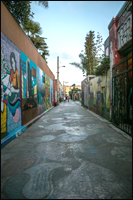Bangkit/Arise, Nano Warsono, Clarion Alley, Mission District, San Francisco, 2018

Bangkit/Arise is an international arts exchange and residency between artists from the San Francisco/Bay Area, USA and Yogyakarta Indonesia. The lead sponsoring organization for Bangkit/Arise is Clarion Alley Mural Project, based in San Francisco in collaboration with the Asian Art Museum Chong Moon Lee Center for Asian Art and Culture. The projects partners in Yogyakarta Indonesia are Desa Panggungharjo and the Institut Seni Indonesia, Yogyakarta.
In July/August 2018 five of the artists from the SF/Bay Area – Kelly Ording, Jet Martinez, Jose Guerra, Christopher Statton and Megan Wilson arrived in Yogyakarta to spend 5 – 7 weeks as part of the residency exchange. Unfortunately because of greater geopolitical circumstances, two of the Bay Area artists – Shaghayegh Cyrous and Keyvan Shovir were unable travel and to be a part of the first phase of the exchange; however, they are still very much a part of the exchange and will be traveling to Yogyakarta as soon as it is possible.
On September 3rd six of the Yogyakarta artists – Nano Warsono, Bambang Toko, Ucup, Wedhar Riyadi, Vina Puspita and Harind Ndarvati arrived in San Francisco to spend 8 weeks in the Bay Area getting to work with our communities here. Sadly, one of the Indonesian artists – Codit – was unable to be a part of the current residency in San Francisco due to greater geopolitics; however, he too is still part of the exchange and will travel to San Francisco when possible.
HO
The first Bangkit/Arise mural to be painted in San Francisco was the result of an unexpected and unfortunate incident on Clarion Alley. Two weeks before the Indonesian artists arrived in San Francisco, a young naive artist from out-of-town showed up on Clarion Alley and painted over a mural space that had belonged to a CAMP artist for almost two years. Within one week someone bombed her mural with black spray paint. As a result CAMP needed to install a new mural in the space quickly. Therefore, Nano Warsono offered to help CAMP with the situation. Nano created an entire new mural based on dualities, disagreements, and resolution. He titled the work Ho.

HO is the first letter in the Javanese alphabet. HO means the beginning of everything; the beginning of being. In Wayang Javanese shadow puppet theater the beginning of the universe is represented by two characters – Semar and Togog. These two gods live in the world as ordinary men – one is the guide of humans in the north; the other in the south. Semar represents good and Togog evil – and they are in constant dialogue. The banana tree represents the philosophy that life must be used to its fullest. All parts of the banana tree are in full use in Javanese culture, from leaf, flower, stalk, and fruit, working in harmony. The two characters Semar and Togog on the mural were created from characters in both the Arabic and the Javanese alphabets to become a mantra and talisman for protection, strength, and good fortune.
While Nano and Megan were on the alley as Nano was painting the mural a becak unexpectedly showed up on Clarion Alley. Becaks are the bicycle and motorbike rickshaws that are a form of transportation in Indonesia. Even stranger was that the becak had been painted by artist Arie Dyanto in Yogyakarta Indonesia. Arie was one of the artists who was a part of CAMP’s first international exchange between SF/Bay Area and Yogyakarta in 2003 – Sama-Sama/Together.
Bangkit/Arise is designed to foster discussions, understanding, and action on critical social/political issues facing our global and local communities today using art as a point of departure. Subjects being addressed include:
- Community development and the role of art in supporting Civic Design through:
- Creating a culture of creativity;
- Placemaking;
- Community building and networking;
- The engagement of residents and visitors/tourists; and
- Economic growth and livelihood – the creative economy;
- The role of the public commons;
- Environmentalism and the critical need for a call to action;
- Current geopolitical divisions, xenophobia and how we envision a world rooted in social justice, equity, and collaboration;
- The need for radical inclusion and understanding differences and similarities as a means of strength and the goal of collectively dismantling local and global inequities/oppression.

SEMANGAT!


















